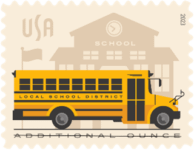With the release of this new additional ounce stamp, the U.S. Postal Service celebrates the iconic yellow school bus and its role in ensuring that millions of children get to school and home again every day.
The stamp features a stylized illustration of a 21st century yellow school bus, in profile in front of a silhouetted schoolhouse that is more evocative of an earlier era. Just under the building’s gable roof, a clock shows 10 minutes to 8; the morning bell will ring soon.
Although vehicles dedicated to transporting children to and from school have operated since the late 19th century, it was only in 1930 that the modern, enclosed, steel school bus came into being. And it was in 1939 that “National School Bus Chrome” first became the vehicle’s standard color. That year, a group of state transportation officials and bus and paint manufacturers gathered at Columbia University’s Teachers College, in New York City, to develop safety and fabrication standards for school buses. The group tested various colors and determined that black lettering showed most legibly on yellow, especially in the dim light of dawn or dusk. Thirty-five states immediately began mandating that color, but it was not until 1974 that all states did.
Over the years, many of the original 1939 standards have changed, but not the color. Additional standards have been adopted to require a mechanical stop arm on the driver’s side of the vehicle, various amber and red flashing lights, and cross-view mirrors, all designed to halt traffic when the bus stops to take on or discharge children. Other, more recent requirements have involved equally important but less outwardly visible alterations to protect passengers in case of rollovers, collisions, and other mishaps.
About 25 million children across the United States ride a yellow bus to school every day. Besides providing reliable and safe transportation—a child is about 70 times safer riding the bus than being driven to school in a car—these buses keep millions of cars off the road, saving billions of gallons of gasoline and preventing millions of pounds of harmful carbon dioxide emissions. Yet each bus remains its own little world, where countless childhood dramas play out, friendships form and dissolve, and daydreams are dreamed as the landscape passes.
Artist Steve Wolf worked with art director Greg Breeding and designer Mike Ryan to create this stamp, which will be sold in panes of 20 and coils of 100.
The words “ADDITIONAL OUNCE” on this stamp indicate its usage value. Like a Forever® stamp, this stamp will always be valid for the rate printed on it.
Product Specification:
| Issue: | School Bus Stamp |
| Item Number: | 122400 |
| Denomination & | Non-denominated Additional Ounce Rate |
| Type of Issue: | |
| Format: | Pane of 20 (1 design) |
| Series: | N/A |
| Issue Date & City: | January 5, 2023, High Point, NC, 27260 |
| Art Director: | Greg Breeding, Charlottesville, VA |
| Designer: | Mike Ryan, Charlottesville, VA |
| Artist: | Steve Wolf, Austin, TX |
| Modeler: | Sandra Lane/Michelle Finn |
| Manufacturing Process: | Offset, Microprint |
| Printer: | Banknote Corporation of America |
| Press Type: | Gallus RCS |
| Stamps per Pane: | 20 |
| Print Quantity: | 100,000,000 stamps |
| Paper Type: | Phosphor, Block Tag |
| Adhesive Type: | Pressure-sensitive |
| Colors: | Magenta, Yellow, Black, Pantone 9202, Pantone 4248, Pantone WM Gray 9 |
| Stamp Orientation: | Horizontal |
| Image Area (w x h): | 1.05 x 0.77 in./26.67 x 19.558 mm |
| Overall Size (w x h): | 1.22 x 0.91 in./30.988 x 23.114 mm |
| Full Pane Size (w x h): | 5.76 x 5.55 in./146.304 x 140.97 mm |
| Plate Size: | 160 stamps per revolution |
| Plate Number: | “B” followed by six (6) single digits |
| Marginal Markings: | |
| Front: | Plate number in four corners of pane |
| Back: | ©2022 USPS • USPS logo • Two barcodes (122400) • Plate position diagram (8) • Promotional text |






